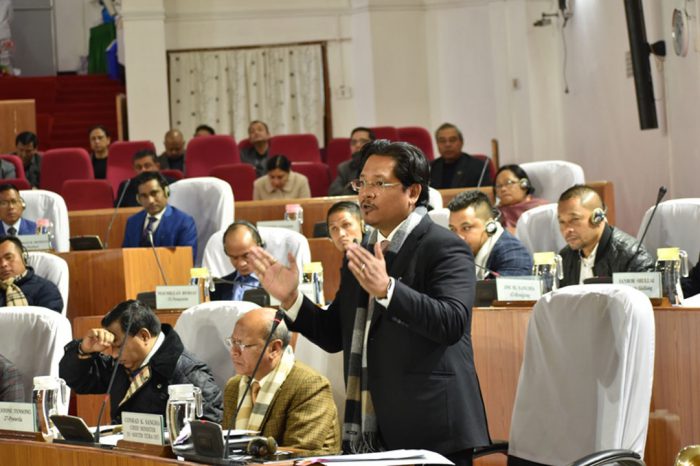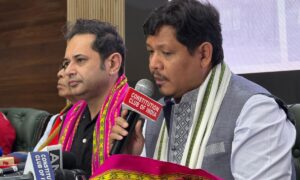
It is somewhat surprising that the implications of extension of the Inner line Permit system to the whole of Manipur state under a Presidential notification dated 11th Dec 2019 have not received the due attention in the media, though the fact that the decision has prompted the govt of Meghalaya to press for the same for which the state Assembly passed a resolution (unanimously on December 19, 2019) soon after urging the center to extend the ILP system to Meghalaya was duly noted.
And right now a section of the Assamese agitating against the Citizenship Amendment Act have also demanded its extension to Assam. To appreciate it in the larger context we must note that extension of ILP to the whole of Manipur state, a non tribal majority State which wasn’t even a part of the British held India as it was a Princely state is indeed a momentous develelopment. This is because since the enactment of the Bengal Eastern Frontier Regulation in 1873 which provides for the ILP regime no administrative unit other than those originally notified in 1873 viz – the areas which now form Arunachal Pradesh, Nagaland and Mizoram was ever added nor its provisions extended to an area that wasn’t a part of Bengal Presidency. Second it has been extended in the 21st century to Manipur when the main objects and reasons for which the BEFR 1873 was enacted are no longer relevant. For better understanding of the matter some facts of history must be noted.
The whole of NE of today was perceived by the British as”the Eastern Frontier of Bengal Presidency” – the bridge head of the British power in India. The tribal areas were defined even as late as 1935 under section 311(1) of the GOI Act 1935 as ” areas along the frontiers of India and Balochistan which are not part of India or Burma or of any indian state or of any foreign state”.
Much before this approach expansion of the British power to NE Hill areas inhabited by tribes after annexation of the Ahom kingdom( Assam Proper) in 1826 a distinction was made between the hill areas located in the periphery of Bengal such as Garo hills and Khasi and Jaintia hills and to a certain extent the Mizo Hills and the Hill areas between “Assam proper” and Tibetan plateau and Burma; because the British deliberately kept parts of the Naga and Mizo inhabited areas under its Burma province.( Chin Hills and Naga Self administered territory of present Myanmar). This holds good for the areas under NEFA , now Arunachal Pradesh bordering Tibet.
This strategic perception led to two different systems administration of tribal areas: For the hills in the periphery of Bengal,it was the Garo Hills Act 1869 which was extended to Khasi and Jaintia hills and later The Scheduled Districts Act 1874 provided a system of administration of criminal and civil justice in which the Deputy Commissioner was empowered with the powers of the Magistrate and Judge. The object was ” resource extraction” – coal, Limestone, timber which necessarily brought the traders of the plains in these Districts that the colonial state didn’t quite object. But in the ” border lands” adjacent to Burma and Tibet interaction of tribals with the plainsmen – especially the money lenders and traders was considered inimical to the British interest for a strategic reason as it might strengthen the tribes’ links with Indian plains and thereby reduce and even foreclose the possibility of using these areas in the larger power game that involved France for control of parts of Indo China Thailand,Burma, Tibet and even coastal China. . BEFR1873 was designed to meet this strategic need to keep these” tribal border areas isolated”; and hence the Regulation was to provide a legal framework to” deal with a pressing necessity of bringing under stringent control commercial relations of our own subjects ( meaning plainsmen) with the frontier tribes”. One must note that its target was not Hill tribes perse but the ” frontier tribes” for whose ostensible protection the permit system for entering the tribal areas as notified under the BEFR 1873 and associated restrictive provisions for entry into the areas notified and acquisition of immoveable property and permanent residency of plainsmen in the ” Inner line” areas as laid down in the Regulation.
Notwithstanding this distinction all tribal areas of Assam were designated as ” Backward areas” under section 52 (2)of the Government of India Act 1915 by a notification issued by the Governor General as listed below:
1. Garo Hills District 2.The British portion of the K and J Hills other than the Shillong Municipality and Cantonment.3.The Mikir Hills 4. North Cachar hills 5. Naga Hills 6. The Lushai Hills 7.Sadiya Frontier tract 8.Balipara Frontier tract 9 .Lakhimpur Frontier tract. (All these areas were put under the Sixth schedule of the Constitution as originally enacted.) Interestingly under the Government of India Act 1935 the generic term ” Backward areas” gave way to a classification of the tribal areas into ” excluded and” partially excluded areas” under which the areas in the periphery of Bengal and the settled Districts- Garo, Khasi and Jaintia hills and Mikir Hills were put in the” Partially excluded areas “and the rest in the excluded category laying down a three tiered system for administration of tribal areas– Areas under the ILP system within the ” Excluded areas”,Other Excluded areas and the Partially excluded areas. The reason was clear that the” Partially excluded areas” are more advanced being already a part of the the colonial extractive econmy and the communication system linking other Districts through these areas like the vital Guwahati- Shillong- Silchar road. It therefore implied that the circumstances which would suggest introduction of the ILP regime under the BEFR 1873 did not exist even in 1935 in tribal areas which form Meghalaya State today. Even then all ” excluded and partially excluded areas” were included in the Sixth schedule of the Constitution. It was however not possible for several strong reasons to introduce autonomous institutions of tribal governance under the Sixth Schedule in Naga Hills and Frontiers Tracts as the Governor’s notification to form the autonomous areas could not be issued and these Areas were removed from the Sixth schedule after formation of the state of Nagaland in 1963 and the union territory and later State of Arunachal Pradesh though these Areas remained and still remain under the Inner line Permit system ever since the notification issued by the Governor General in 1873.
In this backdrop the Center’s decision to extend ILP system to Manipur , a non tribal majority State to meet the long-standing demand of the ethnic Meitei of the Imphal valley for ” protection of their majority status ” by restricting movement of tribals and other Indians” from its neighborhoods and Myanmar has left many issues unaddressed .As for example if this is in conformity with the Centre’s decision to connect Manipur by rail or opening up the NE states especially a border state like Manipur under the Act East Policy to trade and investment from the Asean countries ; as it demands a liberal movement of capital and technology and certainly not more barriers which ILP regime is certain to put in place.
Next this decision has already created demand for its introduction in Assam by a section of the political class apart from formal demand by Meghalaya though a case for ILP in both the states cannot stand a serious scrutiny. Meghalaya is overwhelmingly tribal as over 80% of its population has been tribal since its inception as a state in 1971 because of the effective protection of tribal land, political and other rights under the Sixth Schedule and the severe restrictions the schedule imposes on non tribal citizens to hold immoveable property or to carry on with trade and other professions in the state. Further its location as the hub of the National High way system connecting Assam and rest of India with Barak valley Districts of Assam and also Mizoram and Tripura suggests that ILP will be hard to implement and will entail enormous administrative problems. But more importantly it will obstruct flow of capital and technology and thereby the expansion of the tribal capitalism and entrepreneurship which is an important feature of Meghalaya today. Since grant of Sub statehood in 1969 the Meghalaya tribes have come a long way and are no longer in need of protection from ” cunning traders and especially money lenders from the plains of Assam” which was among the reasons to promulgate the BEFR in 1873 and more because Meghalaya is a state committed to promote ” tribal interest”and after central funding under12 Five year Plans its economy is no longer ” tribal ” as it displays all features of a ” capitalist extractive economy”as tribal entrepreneurs presently dominate mining, manufacturing and service sectors.
In fact this phenomenon is also seen in Arunachal Pradesh, Nagaland and Mizoram in good measure. This suggests that no forward looking society anywhere in today’s globalising world of the 21st century would opt for reversion to tribal world of 19th century colonial State when the ILP was enforced to meet the strategic object of the British colonial state. For Meghalaya it will be a recipe for economic suicide.
Finally there is a geopolitical and security dimension of any decision on extension of the ILP system in North East border lands as well : Because the requirement to obtain a permit by an Indian citizen from any other part to visit a ILP state and the restrictions it imposes on them to do business or acquire im moveable property etc will put the ILP state and its citzens on a separate plane altogether.
This appears rather incongruous as the citizens of the ” ILP States” could freely move and settle in any part of the Union of India while the other Indians cannot even freely visit the ILP areas, which to put it mildly , is a step certain to create vested interest in maintaining and enhancing separate identities and a ” Balkanised border lands” in the North East is what our adversaries in the neighborhood – present and future would always welcome!.
The ” Inner line” was once the ” line of control ” of the colonial power designed to keep the tribes isolated . The world has changed since then as what the tribes do need now is a” development and not a paternalistic state “; and with Manipur, now a ILP State all four states bordering with China and Myanmar in the north east are now ILP states and this has strategic implications because of the areas’ proximity to South China and especially the deepening of China Myanmar relations now firmly set under the China Myanmar Economic Corridor.
[the_ad id=”22718”]


















